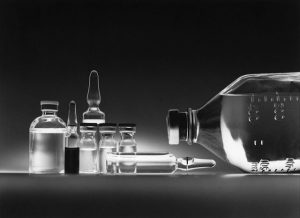Modern (1940’s-present)
65 Cancer Chemotherapy: Alkylating Agents
Sophie Herman
Introduction
Cancer is a disease resulting from uncontrollable cell growth in the body. Human cells grow old or become damaged and eventually die allowing for new cells to replace the old. However, there are times when this process does not go accordingly and abnormal cells begin multiplying. These cells may form tumors which are lumps of tissues that can be cancerous or not cancerous. Cancerous tumors have the ability to spread to other parts of the body (National Cancer Institute, 2021).
Chemotherapy is a common treatment for cancer with the goal of prolonging survival and providing symptom relief. It is the administration of chemicals with cell-killing properties in hopes of suppressing cell growth and division (Nygren, 2001).
Connection to STS
Chemotherapy is such a powerful technological advancement that has made rapid development in cancer treatment. In relation to STS, curiosity led to the pursuit of new knowledge which resulted in the creation of chemotherapy. The treatment provides patients with a chance of reaching complete remission forever changing the lives of not only the patients, but also their loved ones. With cancer being the second leading cause of death in the US, this creation has immensely impacted society as a whole.

Alkylating Agents
Alkylating agents are a class of drugs frequently used in this therapy. These drugs damage the DNA of cancer cells during all stages of the cell cycle preventing cell reproduction and can eventually lead to tumor cell death and mutagenic damage. Alkylating agents are capable of treating many cancers including lung, breast and ovary cancers as well as leukemia, lymphoma, Hodgkin disease, multiple myeloma and sarcoma (American Cancer Society, 2019).
However, resistance to alkylating agents can develop, leading to treatment failure and disease progression. The expression of the O6-methylguanine-DNA methyltransferase (MGMT) enzyme can influence the effectiveness of the therapy drugs. Tumors with high levels of MGMT are more resistant to alkylating agents, while tumors with low levels of MGMT are more sensitive to these drugs (Sarkaria et al., 2008).
History of alkylating agents
Alkylating agents emerged during World War I when mustard gas, a vesicant chemical agent, was used as a weapon. It acted as an alkylating agent by damaging the DNA of cells resulting in low levels of red or white blood cells and platelets. The first developments were made when treating the exposed patients, noting the profound decrease in blood cells. However, the major findings occurred during World War II following an accidental emission of sulfur mustards after a ship was bombed. Upon examining the fallen victims, a physician focused primarily on the low white blood cell count. Because white blood cells are known for rapid cell division, these researchers were able to believe that this agent had the potential to kill cancer cells since they are also capable of rapid cell division (Godoy, 2014).

To test their theory, two pharmacologists began experimenting with nitrogen mustard on mice containing a transplanted lymphoid tumor. After observing regressions in the tumor growth, they took their findings to a surgeon where he administered nitrogen mustard to the first human patient with non-Hodgkin’s lymphoma. Once again, regression of the tumor was observed.However, these remissions were not long lasting (DeVita & Chu, 2008).
Physicians were not ready to give up. More research was conducted examining chemical agents with similar effects to those of nitrogen mustard. Studies gave rise to new therapeutic drugs. With these discoveries, cancer treatment continued to evolve and scientists began combining chemotherapy agents which allowed for longer remission in cancer patients, particularly for lymphomas and leukemia (Godoy, 2014).
Missing Voices
Despite the increasing survival rates with the use of therapeutic drugs, many cancer patients and their loved ones are left with an intimidating financial burden, forcing them to make gut-wrenching sacrifices. Because of these costs, many patients reported struggling to buy food, avoiding doctor appointments or follow-up tests, lowering doses of prescriptions, skipping recommended treatments and even declaring bankruptcy. Another sad truth is that cancer treatment expenses, at an average total of $150,000, is more than four times the price of treatment for other common health conditions (Selby, 2004). Imagine having a chance at remission, but being unable to pay for the drugs that would allow you to reach that point of recovery.
COnclusion
Cancer mortality rates have steadily declined in the United States since the early 1990s (DeVita & Chu, 2008). The discovery of chemotherapy and, more specifically, alkylating agents has played a major role in these findings. Professionals continue the search for effective strategies to combat the resistance of cytotoxic agents and to find new drugs in general with the intention of granting these patients a life of complete remission. However, it is crucial that society as a whole advocates for those unable to afford these immense costs for the treatment necessary to save one’s life.
AI Use disclosure
I used scite.ai to help me find information about cancer chemotherapy, and more specifically alkylating agents, that fits the goals of this textbook chapter. It gave me sources from outside the western world. I then used the other sources I had gathered to apply other elements to the chapter.
Scite.ai. (2023). scite.ai (beta version) [Large Language Model]. https://scite.ai/assistant
References
American Cancer Society. (2019). How Chemotherapy Drugs Work. https://www.cancer.org/cancer/managing-cancer/treatment-types/chemotherapy/how-chemotherapy-drugs-work.html#:~:text=Alkylating%20agents%20keep%20the%20cell,%2C%20multiple%20myeloma%2C%20and%20sarcoma
DeVita, V. T., & Chu, E. (2008). A history of cancer chemotherapy. Cancer Research, 68(21), 8643–8653. https://doi.org/10.1158/0008-5472.can-07-6611
Godoy, N. (2014). The birth of cancer chemotherapy: accident and research. Pan American Health Organization. https://www3.paho.org/hq/index.php?option=com_content=&view=article=&id=9583=&lang=en#gsc.tab=0
National Cancer Institute. (2021). What is Cancer?. https://www.cancer.gov/about-cancer/understanding/what-is-cancer
Nygren, P. (2001). What is cancer chemotherapy? Acta Oncologica, 40(2-3), 166-174. doi:10.1080/02841860151116204
Sarkaria, J. N., Kitange, G. J., James,C. D., Plummer, R., Calvert, H., Weller, M., & Wick, W. (2008). Mechanisms of Chemoresistance to Alkylating Agents in Malignant Glioma. Clin Cancer Res, 14(10), 2900–2908. https://doi.org/10.1158/1078-0432.CCR-07-1719
Selby, K. (2004). High Cost of Cancer Treatment. Asbestos.com. https://www.asbestos.com/featured-stories/high-cost-of-cancer-treatment/#:~:text=Common%20and%20Costly%20Chemotherapy%20Drugs&text=Depending%20on%20the%20drug%20and,beyond%20the%20average%20annual%20income
Image Citations
“Chemotherapy Vials” by Bill Branson is in the Public Domain<a href=”https://commons.wikimedia.org/wiki/File:Chemotherapy_vials_(4).jpg” target=”_blank”>”Chemotherapy Vials”</a> by <a>Bill Branson</a> is in the <a href=”https://wiki.creativecommons.org/Public_domain” target=”_blank”>Public Domain</a>
“Structural diagram of melphalan” by Fvasconcellos is in the Public Domain<a href=”https://commons.wikimedia.org/wiki/File:Melphalan.svg” target=”_blank”>”Structural diagram of melphalan”</a> by <a>Fvasconcellos</a> is in the <a href=”https://wiki.creativecommons.org/Public_domain” target=”_blank”>Public Domain</a>

